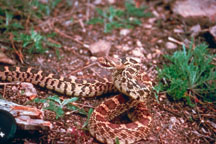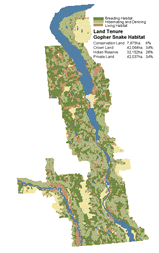|
Habitat Atlas for Wildlife at Risk
Gopher Snake
Pituophis melanoleucus deserticola

Gopher
Snake
|

- Other Names: Great Basin Bull Snake,
or Desert Gopher Snake.
- Length: 1 to 2 m; large, heavy-bodied snakes.
- Tan-coloured body marked with rows of dark brown
or black blotches; dark blotches become a series
of cross-bands
on the tail.
- Small head; dark lines run from jaw to eyes and
across head.
- Readily distinguished from the Western Rattlesnake
which has a broad, triangle-shaped head and rattle
at end of tail.
Status:
British Columbia Blue List
Special Significance
In British Columbia, the small population of Gopher
Snakes is found primarily in the dry valleys of the
southern portion of the province. Human development
has encroached on many portions of the range of Gopher
Snakes and has undoubtedly caused population declines.
These snakes may have an important role in agricultural
areas where rodents can cause crop damage. Gopher
Snakes are protected under the British Columbia Wildlife
Act. However, these creatures are vulnerable to needless
killing by humans because of their similar appearance
to the Western Rattlesnake. The most significant
threat to Gopher Snake populations continues to be
rapid habitat change as a result of human activities.
Distribution
- In British Columbia, found in the Thompson, and Okanagan valleys,
the Fraser Valley from Lillooet to Lytton, west
along the Similkameen River almost to Princeton, and near Grand
Forks.
- Mainly found in the grasslands and ponderosa pine parklands.
Habitat
- Summer range consists of shrub-steppe grasslands adjacent to streams
and ponds.
- Snakes occupy habitats supporting sizable rodent populations.
- Nesting sites may include sandy, southern exposed slopes,
talus and rock outcrops.
- Hibernation sites are found in southern facing rocky
slopes with many deep fissures; large piles of
loose rock are also used as hibernating sites.
Reproduction
- Gopher Snakes emerge from the hibernation site in April and disperse
shortly thereafter.
- Snakes mate in May and lay 2 to 8 eggs in old rodent
burrows in late June or early July.
- They do not incubate eggs so nest site must be warm
and moist to allow development.
- Eggs hatch in late summer; females and juveniles stay
active in the summer habitat until mid-October.
- Annual reproduction is possible if females can regain
enough fat reserves after egg laying.
Food Habits
- Forage primarily at night; daylight hours usually spent underground
in vacant rodent burrows.
- In British Columbia, probably specialize on rodents;
larger prey species such as cottontail rabbits
are killed by squeezing, smaller rodents swallowed alive.
- Snakes also eat birds and their eggs, insects, lizards,
garter snakes and ground squirrels.
- Eat only once a week or less; meals can weigh as much
as 50 percent of the snake's weight.
- Positively affected by increases in rodent populations
which benefit from agricultural activity.
Interesting Facts
- Gopher Snakes are British Columbia's largest snake.
- Able to hiss and make sharp, sudden sounds like the
snort of a bull (hence the nickname "Bull Snake" ) or
the rattling sound of a rattlesnake.
- Juvenile snakes follow scent trails of adult snakes,
which may assist young snakes in location of den
sites.
- Good climbers; these snakes can sometimes be found
in trees.
- Hibernating dens may be shared with rattlesnakes, racers
and garter snakes.
Encounters
- When cornered, Gopher Snakes may be aggressive and attempt to
bite.
- Gopher Snakes are not poisonous, and pose no threat
to humans.
- Remember - snakes will leave you alone, if you
leave them alone.
Threats
- Extensive land development in the Okanagan has
eliminated or fragmented their habitat
(including dens and feeding grounds).
- Dens are particularly susceptible to human development;
snakes may not relocate to other areas if
dens are destroyed, and availability of suitable winter dens
may be limited.
- Direct killing by humans because
of aggressive behaviour and similarity to
Western Rattlesnake; indirectly killed
on roads.
- Ploughs and other farm machinery could destroy
snake eggs laid in rodent burrows, and pesticides
could impact their rodent prey.
Management Considerations
- Conduct surveys to locate den sites before surface
disturbances occur.
- Identify and protect dens and nesting sites
whenever possible.
- Leave 1 km buffer zone around known den sites
and critical habitats.
- Avoid road construction near talus slopes and
around known snake dispersal routes.
- Avoid disturbing rock and woody debris in
potential snake habitat.
- Maintain good range condition in grasslands
for cover and habitat for prey species.
|
References
1. Shewchuk, C.H. and H.L. Waye. 1995. Draft. Status Report for the
Gopher Snake in British Columbia. Ministry of Water, Land and Air
Protection, Lands and Parks. Victoria, British Columbia.
2. Gregory, P.T. and R.W. Campbell. 1984. The reptiles
of British Columbia. British Columbia Provincial Museum Handbook No.
44. Victoria, BC.
3. Orchard, S.A. 1984. Amphibians and Reptiles of British
Columbia; an Ecological Review. Ministry of Forests. Victoria, British
Columbia.
|